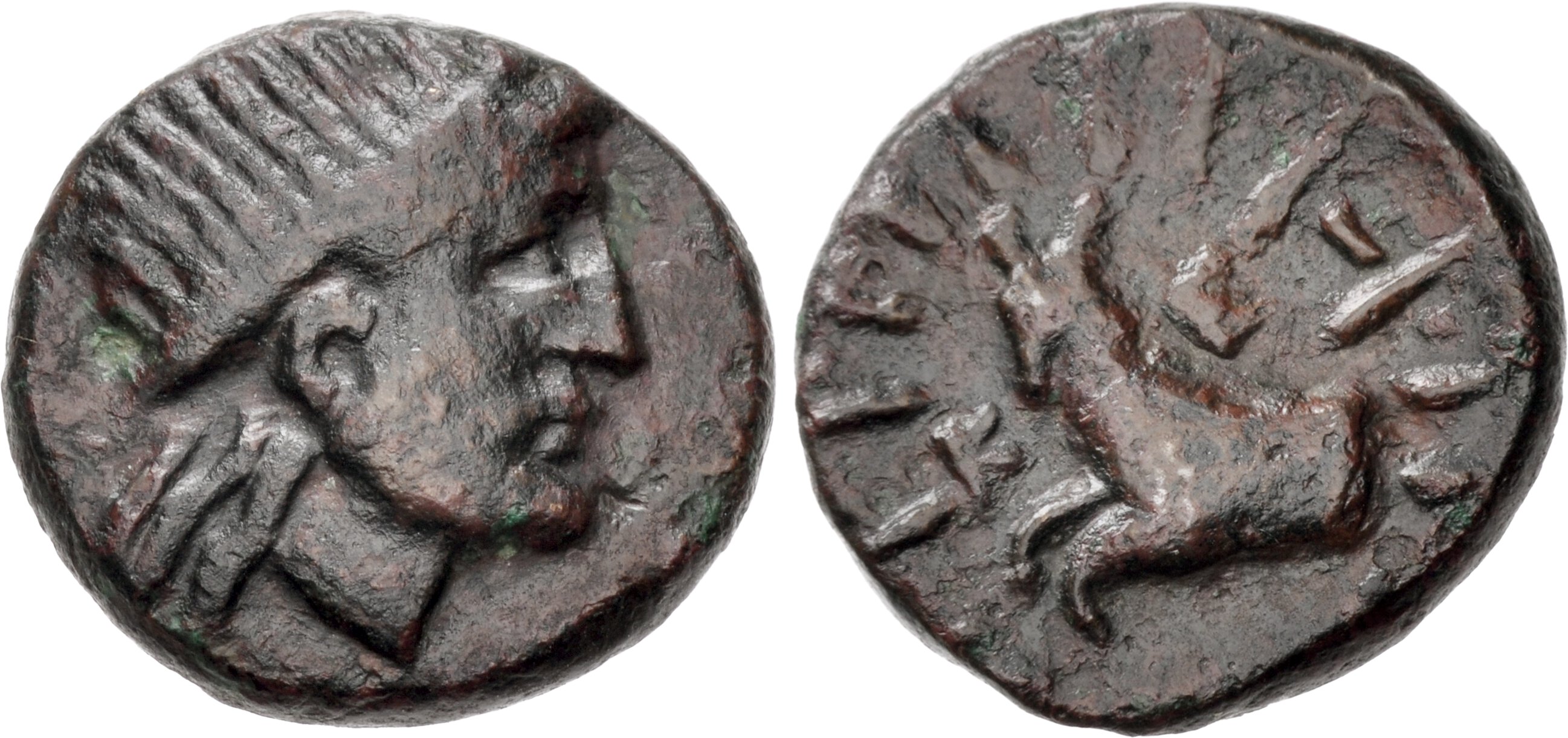S 575 - Kea (uncertain mint), bronze (Aristaeus/Sirius) (220-180 BCE)
From SILVER
220 BCE - 180 BCE Bronze
Description
| ObverseInscription or printing placed on the obverse.: | Radiate head of Aristaeus right |
| ReverseInscription or printing placed on the reverse.: | KE, KEI ou KEIΩΝ (Greek).Forepart of dog (Seirios) left, surrounded by rays |
Mint and issuing power
| MintIdentifies the place of manufacture or issue of a numismatic object.: | Kea (uncertain mint) | Ancient regionAncient region.: | Cyclades | Modern countryModern country: Greece | AuthorityIdentifies the issuing power. The authority can be "pretended" when the name or the portrait of X is on the coin but he/she was not the issuing power. It can also be "uncertain" when there is no mention of X on the coin but he/she was the issuing power according to the historical sources: | Keian League |
Chronology
| FromIdentifies the initial date in a range assigned in a numismatic context. | 220 BCE | toIdentifies the final date in a range assigned in a numismatic context.. | 180 BCE | PeriodTime period of the numismatic object.: Hellenistic 323-30 BC |
Physical description
| MetalThe physical material (usually metal) from which an object is made.: | Bronze |
Median weightMedian of the weights of numismatic objects (in grams). in grams | 4.00 | DenominationTerm indicating the value of a numismatic object. Examples: tetradrachm, chalkous, denarius.: | StandardStandard.: |
Image

S575 Keian League.jpg [1]
References
| Die study referencePublication of the study: | Papageorgiadou-Banis 19971Papageorgiadou-Banis 1997, p. 102-106, n° 13-139 (series II) | ||
| Coin series referenceReference to coin series study: | Sear I2Sear I, n° 3076 | ||
Obverse dies distribution
| FrequencyFrequency of specimen in distribution. ᵖ | Number of obversesNumber of obverse dies. ᵖ (o) | % (o) | Number of coinsNumber of coins. (n) | % (n) | Die nameName(s) of the die(s). |
| 1 | 19 | 43.18 | 19 | 11.38 | 17, 21, 26, 27, 29, 34, 35, 36, 37, 38, 39, 40, 42, 49, 50, 51, 52, 54, 55 |
| 2 | 5 | 11.36 | 10 | 5.99 | 20, 22, 24, 33, 53 |
| 3 | 3 | 6.82 | 9 | 5.39 | 30, 32, 43 |
| 4 | 5 | 11.36 | 20 | 11.98 | 12, 15, 31, 41, 46 |
| 5 | 3 | 6.82 | 15 | 8.98 | 16, 19, 48 |
| 7 | 1 | 2.27 | 7 | 4.19 | 28 |
| 8 | 1 | 2.27 | 8 | 4.79 | 23 |
| 9 | 3 | 6.82 | 27 | 16.17 | 13, 14, 44 |
| 10 | 1 | 2.27 | 10 | 5.99 | 25 |
| 11 | 1 | 2.27 | 11 | 6.59 | 47 |
| 14 | 1 | 2.27 | 14 | 8.38 | 18 |
| 17 | 1 | 2.27 | 17 | 10.18 | 45 |
| Total | 44 of 44 | 99.98 | 167 of 167 | 100.01 |
Reverse dies distribution
no distribution is available
Quantification
| Number of obversesNumber of obverse dies. ᵖ (o) | 44 | Number of singletons (o1)The number of singleton coins. ᵖ | 19 |
| Number of reverse diesNumber of reverse dies. (r) | 116 | Number of coinsNumber of coins. (n) | 167 |
| Coins per obverse dieNumber of coins per obverse die. (n/o) | 3.8 | Coins per reverse dieNumber of coins per reverse die. (n/r) | 1.44 |
| Reverse per obverse ratioRatio of obverse dies divided by reverse dies. (r/o) | 2.64 | Percentage of singletons (o1)number of coins (n) divided by the number of singletons (o1) ᵖ | 43.18 % |
| Original number of dies (O) (Carter 1983 formula)The estimation of the number of coins according to Carter 1983 ᵖ | 51.95 | Coins struck if 20,000 as average productivity per dieCoins made if the average productivity for obverses (according to Carter) is 20,000. ᵖ | 1,039,000 |
| Original number of dies (O) (Esty 2011 formula)The estimation of the number of coins according to the singleton formula in Esty 2011 ᵖ (O) | 59.74 | Survival rate if 20,000 as average productivity per dieSurvival rate if average productivity is 20,000. ᵖ | 0.00016 |
| Coverage (o = % of O) (Esty 1984 formula)Esty 1984 - coverage (% of O) ᵖ (o = % of O) | 88.62% | Die productivity if survival rate 1/2,000Average productivity if survival rate is 1/2,000. ᵖ | 6,429.26 |
| Weight of silver (in kg) if 20,000 coins per die (O = Carter formula)Carter 1983 * Median weight * 20000 (*10 if gold or electrum) ᵖ | n.a. | Die productivity if survival rate 1/5,000Average productivity if survival rate is 1/5,000. ᵖ | 16,073.15 |
Remarks